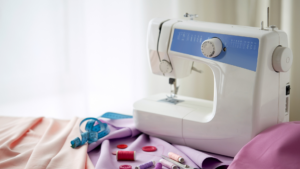Last Updated on June 1, 2022
In the following article, we will share with you everything you need to know about quilting needles for sewing machines.
When you start a new quilting project, you will need the following items: a sewing pattern, a spool of thread, and fabric. But, most importantly, a quilting needle for a sewing machine.
Quilting needles have a strengthened shaft that allows them to stitch through multiple layers of fabric and wadding. Still, they are significantly shorter in length than sharps needles to enable quilters to sew quickly and evenly.
In the following guide, we will teach you all about quilting needles for sewing machines.
Quilting Needles For Sewing Machine
Quilting needles for machines, like their manual counterparts, are made specifically for quilting. To correctly sew the layers of a quilt sandwich together, machine quilting requires sharp needles to puncture through them effortlessly.
But, what makes quilting needles on sewing machines different? As you already know, there are so many different sorts of needles: universal needles, quilting needles, Microtex Sharp Needles, top-stitching needles, and so on.
Yet, how do you tell which type is best for your quilting project? Today, I will explain the distinctions between the various types of sewing machine needles and how to choose the perfect one for your quilting project.
Before we begin, you should know some definitions.
- Point Style – It describes how the needle’s point is fashioned and, in turn, what type of needle it is.
- Sizes – This relates to the needle’s size, which determines the type or thickness of cloth it should be used on and the thread weight.
- Color Code – When the needle is not in its packaging, the color on the shaft indicates what type of needle it is.
- Piecing – The quilt top is created by sewing fabric pieces together.
- Quilting – Stitching across the three quilt layers, top, batting, and backing to keep them all in place (sometimes decorative).
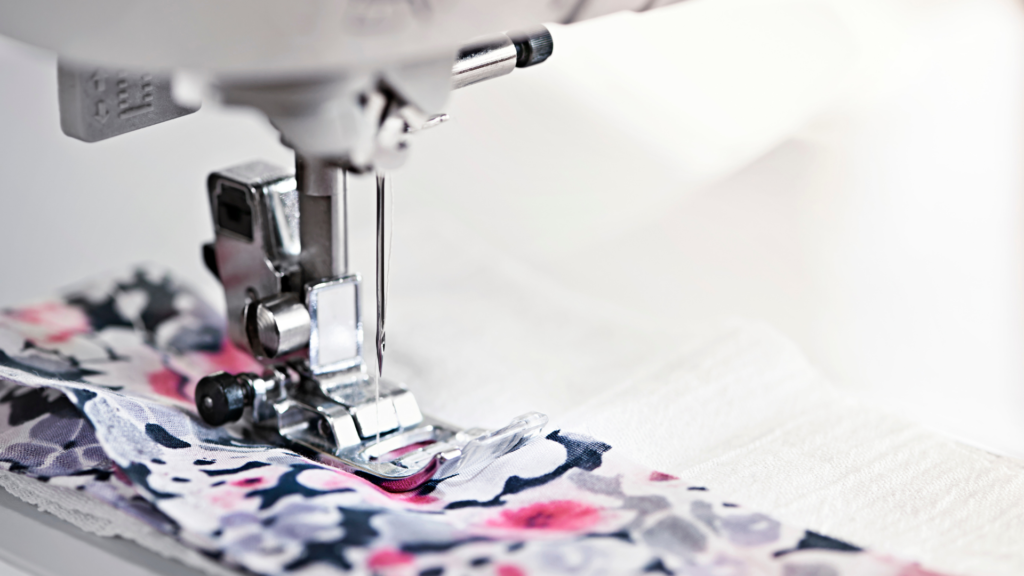
Types Of Sewing Machine Needles For Quilting
Quilting Needles
Quilting needles, like sharps needles, are designed to stitch through multiple layers of fabric and wadding. However, they are significantly shorter in length than sharps needles, allowing quilters to stitch quickly and evenly.
Beginners will usually choose a smaller needle, such as a size 7 or 8. Still, more experienced quilters will prefer a bigger needle. It’s available in sizes 75/11, 80/12, and 90/14, and the needle has a green color code stripe to help you recognize it.
Universal Needles
Universal needles, as the name implies, are the most generally used needle. They can be used with woven textiles, synthetics, and some knit fabrics, but for specific types of knit fabric, see the other needle types listed below.
Lightweight materials are usually sewn with more delicate needles. On medium to heavyweight textiles, larger sizes are needed.
A universal needle should be used with polyester/cotton or silk threads. It comes in various sizes, the most popular of which are 75/11, 80/12, and 90/14.
Sharps Needles
A sharps needle should be used if you’re quilting with numerous layers of cotton and wadding or if you’re dealing with highly woven fabrics like silk and microfiber. These needles are made to function with multiple layers of fabric.
Of course, a stronger shaft prevents bent or broken needles and a sharp point that allows them to pierce the cloth and produce smooth buttonholes. A short round threading eye also adds strength to the stitching process.
Topstitch Needles
Topstitch needles have an exceptionally sharp point that easily pierces various types of cloth. The large eye allows for the use of thick top-stitching thread.
It is available in the following sizes: 80/12, 90/14, and 100/16, with no color code. Because the larger sizes will create larger holes in the cloth, use the appropriate thread size when using these needles.
Microtex Sharp Needle
This needle is intended for fine wovens such as poplin cotton, voile, and lawn and has a thin shaft and sharp point. The point technique is crisp and pointed, producing lovely stitches that are ideal for piecing.
It has a purple code stripe available in sizes 60/8, 65/9, 70/10, 80/12, and 90/14. Because the thinner needle is more likely to break, it should be replaced more frequently. It is advisable to raise the needle size if the needle breaks often.
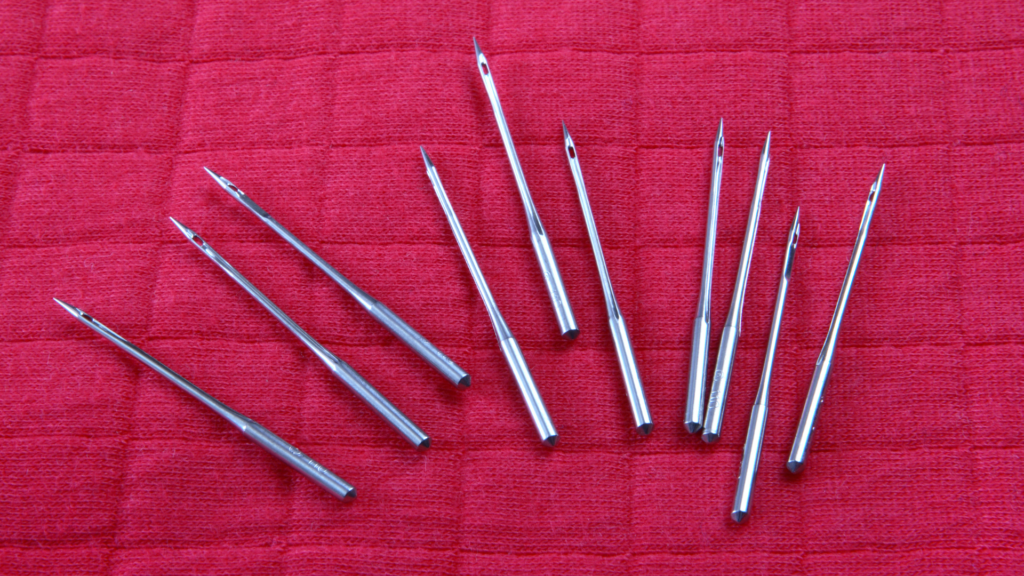
Universal Needle VS Quilting Needle
As the name implies, a universal needle is a needle that may be used for various sewing projects. When you can’t get specialized quilting needles, this needle is the best solution. While this needle is suitable for all-purpose stitching and may also be used for quilting, its tip is not as sharp as a quilting or top-stitch needle.
The ideal needle for piecing and machine quilting is the Quilting Needle. The sharp point of this needle allows it to pierce multiple layers of cloth and sew evenly over seams.
What Size Needle Do I Use For Machine Quilting?
The usual rule is to use a needle that is the same size as the thread you are using. Always remember that the smaller the number, the smaller the needle will be. The needle grows in size as the number increases. Because of how different manufacturers label their needle packages, the size of a needle is occasionally listed as two other numbers.
40-weight and 50-weight threads are the most commonly used on quilting machines. This thread weight is ideal for the size 18/4.0 needle.
For more delicate threads like 60-weight and 100-weight threads, you might want to move down to a size 16/3.5 needle. You may need to use a 19/4.5 needle for thicker threads like strong cotton.
To get the best-looking stitch, most attempt to use the smallest needle to make the smallest possible hole. The eye of your needle will be shaving off the outside of the thread as you quilt.
It’s a good indication that you need to increase the needle size. Of course, if you’ve been quilting fine and suddenly your top thread begins to tear, it’s a sign that your needle is dull.
You should change your needles more regularly depending on the size of the quilt, the density of your designs, and the sorts of fabrics used. But the best piece of advice? Always use a new needle when starting a new project!
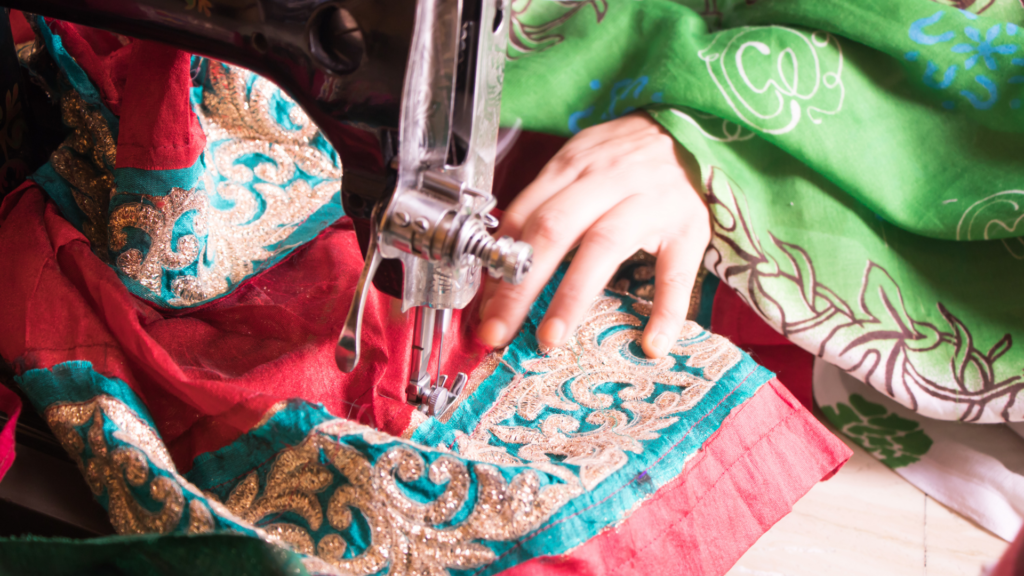
Some Final Words
Stitches are used in quilting to create patterns while also holding the quilt’s layers together.
Sewing is not the same as quilting. The main distinction between sewing stitches and quilting stitches is whether you want the stitches to remain hidden or add to the end product’s appearance.
As a result, to complete a successful quilting project, you must always use the proper quilting needles.

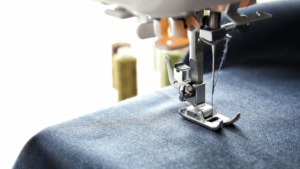
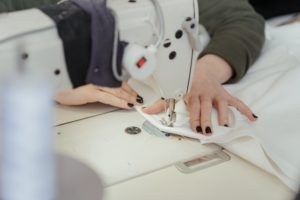
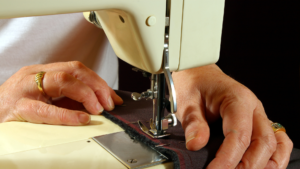
![Read more about the article How To Unfreeze A Sewing Machine: A Comprehensive Guide [2023]](https://www.sewkitkit.com/wp-content/uploads/2021/08/machine-3-300x169.png)
![Read more about the article What To Do If Your Sewing Machine Isn’t Catching Thread [2023]](https://www.sewkitkit.com/wp-content/uploads/2021/08/stitches-2-300x169.png)
